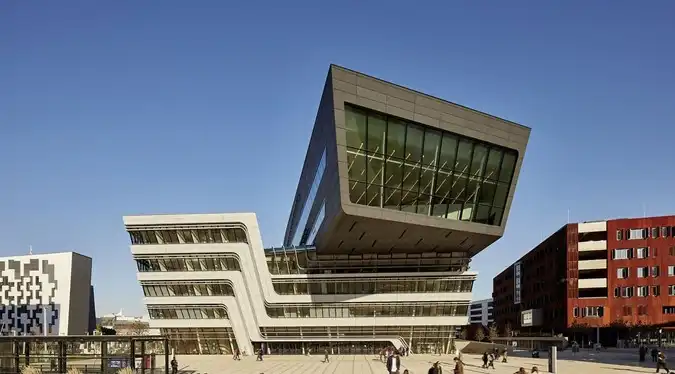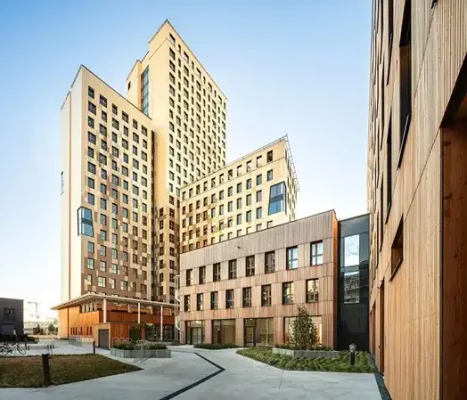Contemporary Architecture in Vienna, Modern Austria building, Alps architectural design wonders
Exploring the Modern Architectural Wonders of Vienna
13 November 2024
Although Vienna, the famous Austrian capital city, is well-known for its classic architectural forms, centuries-old designs, and grand historical buildings, it is also a city in constant evolution. Vienna has embraced a wave of modern architecture that complements its historic landscape while concentrating on function and sustainability. This blend of history and innovation truly shows us what urban living can look like.
Sustainable Design in Vienna
Vienna has been focusing on sustainable options, i.e. energy-efficient buildings, ecological materials, and introducing natural elements to make living even better for its inhabitants. We can already see examples of this devotion in the newer buildings.
Energy-Efficient Buildings
Vienna’s commitment to energy-efficient buildings is part of a broader urban strategy to make the city more sustainable. Passive design strategies utilizing natural energy sources for lighting, ventilation, and orientation reduce energy needs and are widely used by city planners.
One such project is Seestadt Aspern, one of the largest urban development projects in Europe. It is built to become a smart city, leveraging sustainability methods to accommodate over 25,000 residents and create new workplaces. A similar development, the Power Tower in Linz, two hours from Vienna, is Austria’s first high-rise attempt to meet passive house standards. One of the most beneficial things about it is that it requires no fossil fuel to maintain a comfortable climate inside the building. This results in much lower carbon emissions than similar buildings.
Building With Sustainable Materials
Energy-efficient buildings can also include the use of sustainable and innovative building materials such as specific sorts of wood and recycled and bio-based materials. For example, one of the tallest buildings in the future Seestadt Aspern, HoHo Wien will be made of 75% timber and reach as high as 84 meters. This will make one of the world’s tallest wooden skyscrapers (the Ascent building in Wisconsin holds the first place, being 86.6 meters high).
Source: https://www.hoho-wien.at/hoho-wien-eigentuemerwechsel/
Another man-made wonder is the 2226 Building in Lustenau, close to Vienna, which can boast its unique coating, called “climate skin.” It doesn’t have conventional heating and cooling systems; instead, its well-insulated walls and large windows help regulate the temperature inside naturally. The materials used in construction help maintain a comfortable indoor climate year-round.
Integrating Green Spaces
Integrating green spaces and natural elements into Vienna’s urban fabric not only works for Vienna’s cityscape but also serves as a natural air filter and temperature stabilizer. The 3rd District’s Hundertwasserhaus is one of the most famous areas in the city, where both the rooftops and the walls are covered in greenery, making it a bright and picturesque place.
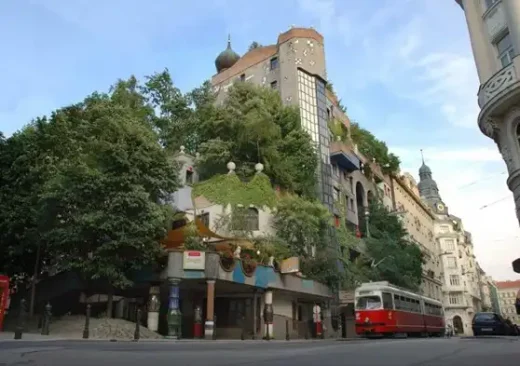
Source: https://hundertwasser.com/architektur/871_arch44_wohnhausanlage_der_gemeinde_wien_-_hundertwasser-haus_1106
A prominent example of improving the image of the city and introducing greenery to already existing objects is Stadtpark, the oldest park in the city, constructed in 1862. It covers 65,000 square meters of land and provides the city’s residents easy access to nature with varied green landscapes, lakes and rivers, and different design forms.
Vienna’s Modern Architectural Landmarks
Although Vienna is known for maintaining and preserving cultural heritage, it also keeps up with modern trends. Thanks to the newest technology and design solutions, new structures are built, and the old ones are transformed to meet today’s sustainability standards.
Adaptive Reuse of Historic Buildings
Adaptive reuse is widely known and used in the Austrian capital. It is the process of repurposing old buildings for new goals while simultaneously retaining their architectural significance. Such an approach can transform different types of structures as old factories, warehouses, and historic buildings.
For instance, MuseumsQuartier is one of the most notable examples of such a trend. Once an imperial stable complex, built in the 18th century, it now serves as a large art and culture hub and hosts a range of galleries, theaters, and museums, including the Leopold Museum and the Museum of Modern Art.
Innovative Contemporary Architecture
Besides historical objects, Vienna also has innovative architectural projects that showcase cutting-edge design and technology, pushing the boundaries of form and function. For example, the DC Tower 1, a skyscraper with a unique twisted design, is the tallest building in Austria. It is not only functional but also designed to maximize natural light and energy efficiency.
Vienna University of Economics and Business (WU) Campus is another example of modern architecture consisting of different architectural styles and designs. Green roofs, natural ventilation, and efficient use of materials further underscore WU’s commitment to environmental sustainability.
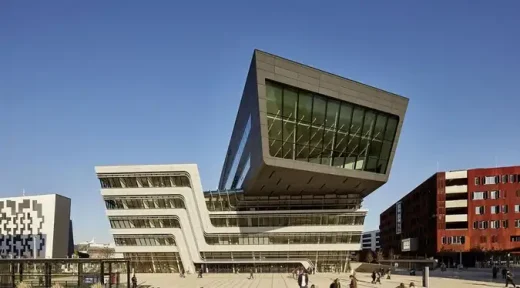
Source: https://www.wien.info/en/art-culture/architecture/wu-campus-366386
Designing Vibrant Public Spaces
As for Vienna’s public spaces, they prioritize accessibility, inclusivity, and community engagement, creating environments where city residents can connect. Donauinsel, or the island in the Danube River, is a prime example of Vienna’s approach to public space design, featuring a variety of recreational areas, parks, and cultural venues. It is accessible to everyone and offers various facilities and activities suited for both relaxation and active leisure.
Karlsplatz is another significant object in the city, with a mix of historical and modern elements. It is surrounded by historical landmarks like Karlskirche and the Vienna University of Technology but also features contemporary installations and is a great and accessible venue for different public gatherings like concerts and festivals. Those seeking to experience Viennese living firsthand and visit all of these spaces can always explore the diverse options in Vienna real estate and feel at home both in historical and modern areas of the city.
Vienna’s Architectural Future
Vienna is a unique place on all accounts, where everyone can find something to their liking, whether it’s a historical monument, green islands in the center of the city, or a glass-covered skyscraper. City planners and architects here follow their own approach, combining traditional constructions with innovative designs.
The emphasis on sustainability can be seen in utilizing energy-efficient methods, introducing smart technologies, integrating green spaces, and adaptive reuse of older buildings. Moreover, all these areas are fully accessible to everyone, transforming them from simple city corners to social clubs.
Comments on guide to Contemporary Architecture in Vienna – Exploring the Modern Architectural Wonders of the Austrian Capital City article are welcome.
Vienna Building Designs
Contemporary Vienna Architecture – recent selection from e-architect:
Vienna Architecture Design – chronological list
Vienna Architecture Tours by e-architect
House B – Addition, not Demolition, Klosterneuburg
Architects: smartvoll
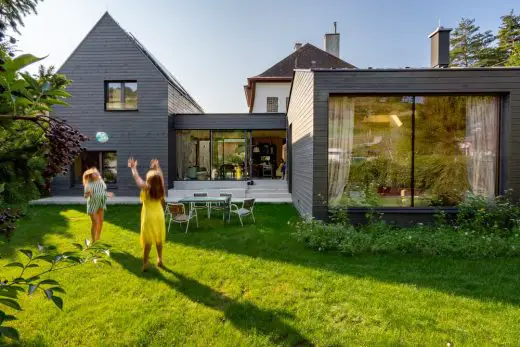
photography : Dimitar Gamizov
House B Addition in Klosterneuburg
Vienna Building – Selection
Marina Tower
Design: Zechner & Zechner ZT GmbH
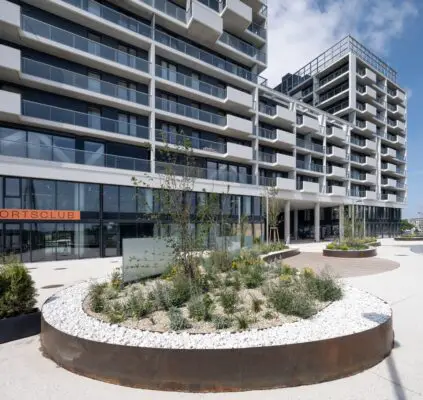
photo : Pierer.net
Marina Tower Vienna Apartment Building
Terra Mater – Sustainable Wooden Office Pavilion in Vienna, Hietzing, 13th District
Design: Berger+Parkkinen Associated Architects
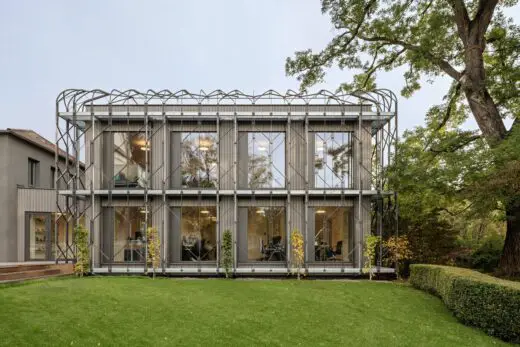
photo © Hertha Hurnaus│Berger+Parkkinen Architekten
Terra Mater Factual Studios Vienna Design
Industrial Kitchen, 23rd district
Design: ATP architects engineers, Vienna
magdas Industrial Kitchen in Vienna
BEL & MAIN
Design: Delugan Meissl Associated Architects
BEL & MAIN Vienna
Telegraf 7 Building, Lehargasse
Design: BEHF Architects
Telegraf 7 Building in Vienna
Comments / photos for the Contemporary Architecture in Vienna page welcome.

